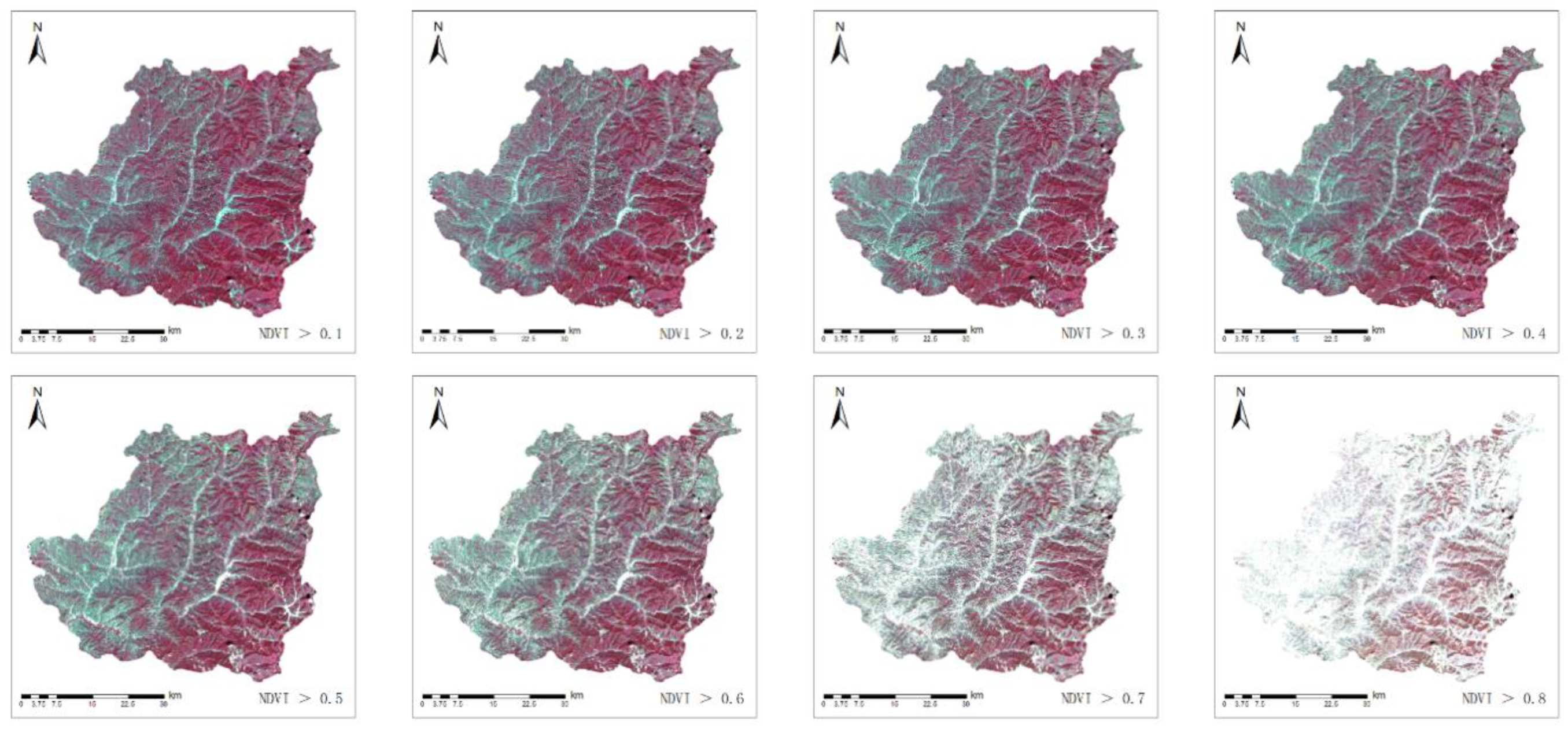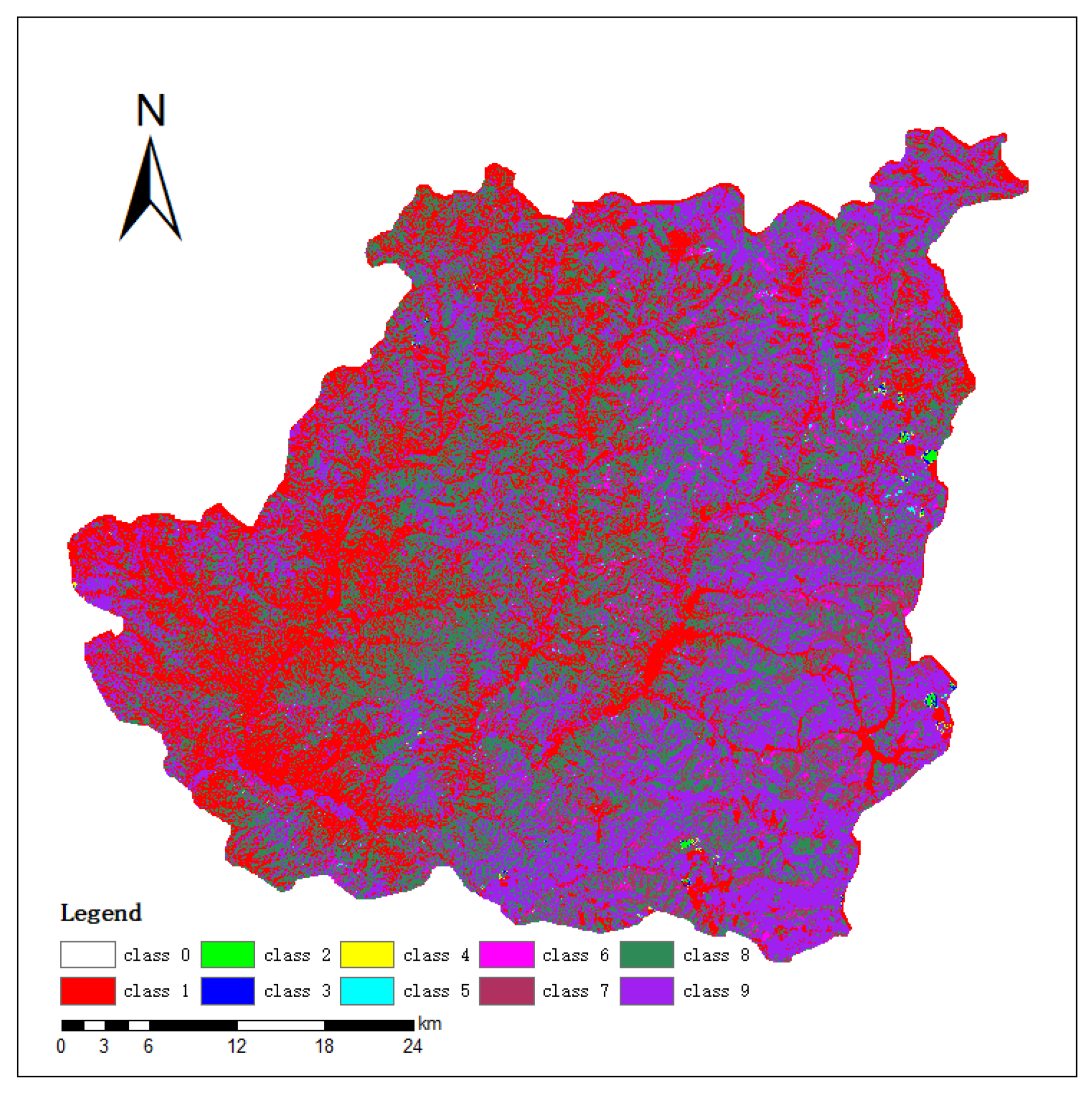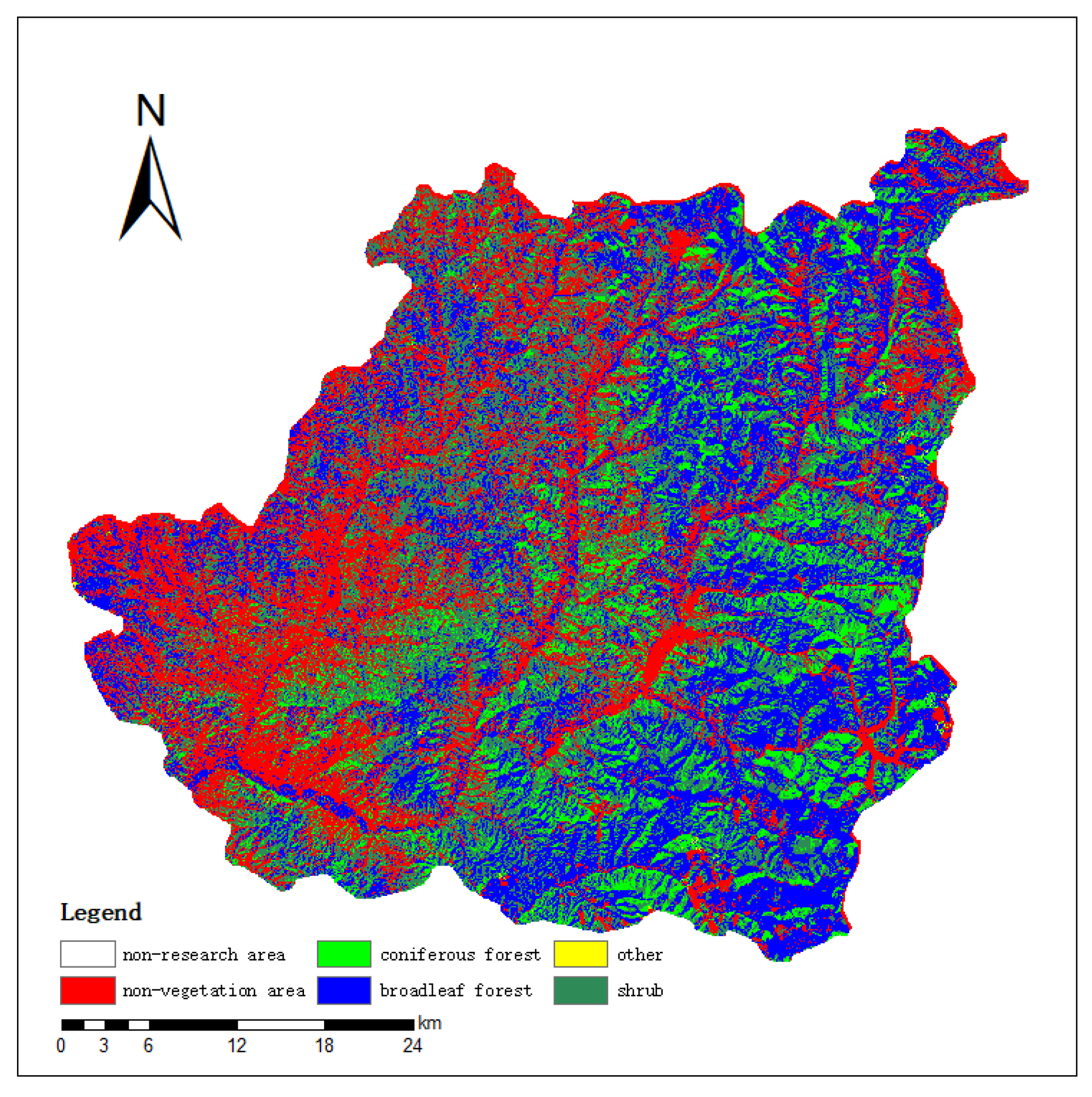Vegetation Classification and a Biomass Inversion Model for Wildfires in Chongli Based on Remote Sensing Data
Abstract
1. Introduction
2. Materials and Methods
2.1. Overview of the Study Area
2.2. The Source and Processing of Data
3. Method
3.1. Vegetation Classification
3.2. Biomass Inversion
3.2.1. Portability Studies of Existing Biomass Models
3.2.2. Construction of a Biomass Inversion Model
4. Results
5. Discussion
6. Conclusions
Author Contributions
Funding
Data Availability Statement
Conflicts of Interest
References
- Bowman, D.M.; Kolden, C.A.; Abatzoglou, J.T.; Johnston, F.H.; van der Werf, G.R.; Flannigan, M. Vegetation fires in the Anthropocene. Nat. Rev. Earth Environ. 2020, 1, 500–515. [Google Scholar] [CrossRef]
- Ganteaume, A.; Camia, A.; Jappiot, M.; San-Miguel-Ayanz, J.; Long-Fournel, M.; Lampin, C. A review of the main driving factors of forest fire ignition over Europe. Environ. Manag. 2013, 51, 651–662. [Google Scholar] [CrossRef] [PubMed]
- Shao, Y.; Wang, Z.; Feng, Z.; Sun, L.; Yang, X.; Zheng, J.; Ma, T. Assessment of China’s forest fire occurrence with deep learning, geographic information and multisource data. J. For. Res. 2023, 34, 963–976. [Google Scholar] [CrossRef]
- Shao, Y.; Feng, Z.; Cao, M.; Wang, W.; Sun, L.; Yang, X.; Ma, T.; Guo, Z.; Fahad, S.; Liu, X.; et al. An Ensemble Model for Forest Fire Occurrence Mapping in China. Forests 2023, 14, 704. [Google Scholar] [CrossRef]
- Zhang, L.; Li, J.; Zhang, F. An Efficient Forest Fire Target Detection Model Based on Improved YOLOv5. Fire 2023, 6, 291. [Google Scholar] [CrossRef]
- Shi, C.; Zhang, F. A Forest Fire Susceptibility Modeling Approach Based on Integration Machine Learning Algorithm. Forests 2023, 14, 1506. [Google Scholar] [CrossRef]
- Shao, Y.; Feng, Z.; Sun, L.; Yang, X.; Li, Y.; Xu, B.; Chen, Y. Mapping China’s Forest Fire Risks with Machine Learning. Forests 2022, 13, 856. [Google Scholar] [CrossRef]
- Xu, Y.; Sun, Y.; Zhang, F.; Jiang, H. Modeling Fire Boundary Formation Based on Machine Learning in Liangshan, China. Forests 2023, 14, 1458. [Google Scholar] [CrossRef]
- Shao, Y.; Fan, G.; Feng, Z.; Sun, L.; Yang, X.; Ma, T.; Li, X.; Fu, H.; Wang, A. Prediction of forest fire occurrence in China under climate change scenarios. J. For. Res. 2023, 34, 1217–1228. [Google Scholar] [CrossRef]
- Xie, Y.; Sha, Z.; Yu, M. Remote sensing imagery in vegetation mapping: A review. J. Plant Ecol. 2008, 1, 9–23. [Google Scholar] [CrossRef]
- Yang, C.; Wu, G.; Li, Q.; Wang, J.; Qu, L.; Ding, K. Research Progress on Remote Sensing Classification of Vegetation. Geogr. Geo. Inf. Sci. 2018, 10, 191–196. [Google Scholar]
- Gao, D.; Liu, Y.; Hu, B.; Wang, L.; Chen, W.; Chen, Y.; He, T. Time Synchronization based on Cross-Technology Communication for IoT Networks. IEEE Internet Things J. 2023, 19753–19764. [Google Scholar] [CrossRef]
- Gao, D.; Wang, H.; Guo, X.; Wang, L.; Gui, G.; Wang, W.; Yin, Z.; Wang, S.; Liu, Y.; He, T. Federated learning based on CTC for heterogeneous internet of things. IEEE Internet Things J. 2023, 10, 22673–22685. [Google Scholar] [CrossRef]
- Gao, D.; Wang, L.; Hu, B. Spectrum efficient communication for heterogeneous IoT networks. IEEE Trans. Netw. Sci. Eng. 2022, 9, 3945–3955. [Google Scholar] [CrossRef]
- Song, W.; Zhang, X.; Chen, Y.; Xu, H.; Wang, L.; Wang, Y. Dimensionality Reduction and Research of Hyperspectral Remote Sensing Images Based on Manifold Learning. arXiv 2024, arXiv:1812.09530v1. [Google Scholar]
- Buddenbaum, H.; Schlerf, M.; Hill, J. Classification of coniferous tree species and age classes using hyperspectral data and geostatistical methods. Int. J. Remote Sens. 2005, 26, 5453–5465. [Google Scholar] [CrossRef]
- Zhu, H.; Huang, Y.; Li, Y.; Yu, F.; Tu, T.; Wang, W.; Zang, Y.; Li, J.; Luo, Y. Diversity of Plant Community in Flood Land of Henan Section of the Lower Yellow River based on Unmanned Aerial Vehicle Remote Sensing. Wetl. Sci. 2021, 19, 17–26. [Google Scholar]
- Li, C.; Wang, J.; Wu, G.; Li, Q. Classification of agricultural plants based on leaf spectral features. J. Shenzhen Univ. Sci. Eng. 2018, 35, 307–315. [Google Scholar] [CrossRef]
- Xin, D.; Huang, X.; Hongga, I.; Shen, L. Research on classification of plant community using projection pursuit learning network algorithm on high resolution remote sensing images. J. Geo-Inf. Sci. 2016, 18, 124–132. [Google Scholar]
- Shi, L.; Liu, S. Methods of estimating forest biomass: A review. Biomass Vol. Estim. Valorization Energy 2017, 10, 65733. [Google Scholar]
- Li, X.; Wang, X.; Gao, Y.; Wu, J.; Cheng, R.; Ren, D.; Bao, Q.; Yun, T.; Wu, Z.; Xie, G. Comparison of Different Important Predictors and Models for Estimating Large-Scale Biomass of Rubber Plantations in Hainan Island, China. Remote Sens. 2023, 15, 3447. [Google Scholar] [CrossRef]
- Wu, H.; Xu, H. A review of the application of sampling techniques in forest biomass inventory. J. Southwest For. Univ.(Nat. Sci.) 2021, 41, 183–188. [Google Scholar]
- Pelletier, F.; Cardille, J.A.; Wulder, M.A.; White, J.C.; Hermosilla, T. Inter-and intra-year forest change detection and monitoring of aboveground biomass dynamics using Sentinel-2 and Landsat. Remote Sens. Environ. 2024, 301, 113931. [Google Scholar] [CrossRef]
- Lu, D.; Chen, Q.; Wang, G.; Liu, L.; Li, G.; Moran, E. A survey of remote sensing-based aboveground biomass estimation methods in forest ecosystems. Int. J. Digit. Earth 2016, 9, 63–105. [Google Scholar] [CrossRef]
- Guo, Q.; Su, Y.; Hu, T. LiDAR Principles, Processing and Applications in Forest Ecology; Academic Press: Cambridge, MA, USA, 2023. [Google Scholar]
- Yali, Z.; Huifang, Z.; Jinglu, Z. Establishment of the Model for Estimating Aboveground Biomass of Populus euphratica Based on UAV Remote Sensing. For. Resour. Wanagement 2019, 80. [Google Scholar] [CrossRef]
- Ye, Q.; Yu, S.; Liu, J.; Zhao, Q.; Zhao, Z. Aboveground biomass estimation of black locust planted forests with aspect variable using machine learning regression algorithms. Ecol. Indic. 2021, 129, 107948. [Google Scholar] [CrossRef]
- Guo, C.; Chen, Z.; Zhang, Z. Research on Remote Sensing Estimation of Forage Above-ground Biomass Based on Optimal Model Selection. Acta Agrestia Sin. 2021, 29, 946. [Google Scholar]
- Yanhui, L.; Xiaoyu, Y.; Nisha, B.; Xiaowei, G. Estimating biomass of reclaimed vegetation in prairie mining area: Inversion method based on Worldview-3 and Sentinel-1 SAR data. Earth Sci. Front. 2021, 28, 219. [Google Scholar]
- Li, T.; Feng, H.; Zhu, B.; Fan, Y.; Jin, L.; Cheng, Q.; Li, Q. Winter Wheat Biomass Inversion Based on UAV Hyperspectral and Digital Image Data. Mod. Agric. Sci. Technol. 2020, 1–5. [Google Scholar]
- Miao, X.; Li, J.; Mu, Y.; He, C.; Ma, Y.; Chen, J.; Wei, W.; Gao, D. Time Series Forest Fire Prediction Based on Improved Transformer. Forests 2023, 14, 1596. [Google Scholar] [CrossRef]
- Zhang, G.; Zhu, S.; Zhang, N.; Zhang, G.; Xu, Y. Downscaling hourly air temperature of WRF simulations over complex topography: A case study of Chongli District in Hebei Province, China. J. Geophys. Res. Atmos. 2022, 127, e2021JD035542. [Google Scholar] [CrossRef]
- Liang, X.; Yang, T.; Niu, J.; Zhang, L.; Wang, D.; Huang, J.; Yang, Z.; Berndtsson, R. Quality Assessment and Rehabilitation of Mountain Forest in the Chongli Winter Olympic Games Area, China. Forests 2022, 13, 783. [Google Scholar] [CrossRef]
- Segarra, J.; Buchaillot, M.L.; Araus, J.L.; Kefauver, S.C. Remote sensing for precision agriculture: Sentinel-2 improved features and applications. Agronomy 2020, 10, 641. [Google Scholar] [CrossRef]
- Zhou, Q. Digital elevation model and digital surface model. In International Encyclopedia of Geography: People, the Earth, Environment and Technology; Wiley: New York, NY, USA, 2017; pp. 1–17. [Google Scholar]
- Pettorelli, N. The Normalized Difference Vegetation Index; Oxford University Press: New York, NY, USA, 2013. [Google Scholar]
- Gitelson, A.A.; Kaufman, Y.J.; Merzlyak, M.N. Use of a green channel in remote sensing of global vegetation from EOS-MODIS. Remote Sens. Environ. 1996, 58, 289–298. [Google Scholar] [CrossRef]
- Rondeaux, G.; Steven, M.; Baret, F. Optimization of soil-adjusted vegetation indices. Remote Sens. Environ. 1996, 55, 95–107. [Google Scholar] [CrossRef]
- Sims, D.A.; Gamon, J.A. Relationships between leaf pigment content and spectral reflectance across a wide range of species, leaf structures and developmental stages. Remote Sens. Environ. 2002, 81, 337–354. [Google Scholar] [CrossRef]
- Blackburn, G.A. Quantifying chlorophylls and caroteniods at leaf and canopy scales: An evaluation of some hyperspectral approaches. Remote Sens. Environ. 1998, 66, 273–285. [Google Scholar] [CrossRef]
- Le Maire, G.; François, C.; Dufrene, E. Towards universal broad leaf chlorophyll indices using PROSPECT simulated database and hyperspectral reflectance measurements. Remote Sens. Environ. 2004, 89, 1–28. [Google Scholar] [CrossRef]
- Haralick, R.M.; Shanmugam, K.; Dinstein, I.H. Textural features for image classification. IEEE Trans. Syst. Man. Cybern. 1973, 610–621. [Google Scholar] [CrossRef]
- Sarker, L.R.; Nichol, J.E. Improved forest biomass estimates using ALOS AVNIR-2 texture indices. Remote Sens. Environ. 2011, 115, 968–977. [Google Scholar] [CrossRef]
- Zhou, X. Urban Vegetation Classification and Biomass Inversion Based on Sentinel-2A Data in Xuzhou; China University of Mining and Technology: Xuzhou, China, 2019. [Google Scholar]
- Xu, Z.; Li, Y.; Li, M.; Li, C.; Wang, L. Forest biomass retrieval based on Sentinel-1A and Landsat 8 image. J. Cent. South. Univ. For. Technol. 2020, 40, 147–155. [Google Scholar]
- Weise, D.R.; Wright, C.S. Wildland fire emissions, carbon and climate: Characterizing wildland fuels. For. Ecol. Manag. 2014, 317, 26–40. [Google Scholar] [CrossRef]
- Gajendiran, K.; Kandasamy, S.; Narayanan, M. Influences of wildfire on the forest ecosystem and climate change: A comprehensive study. Environ. Res. 2023, 240, 117537. [Google Scholar] [CrossRef]
- Nandasena, W.; Brabyn, L.; Serrao-Neumann, S. Using remote sensing for sustainable forest management in developing countries. In The Palgrave Handbook of Global Sustainability; Springer: Berlin, Germany, 2023; pp. 487–508. [Google Scholar]
- Martins, F.d.S.R.V.; Xaud, H.A.M.; dos Santos, J.R.; Galvão, L.S. Effects of fire on above-ground forest biomass in the northern Brazilian Amazon. J. Trop. Ecol. 2012, 28, 591–601. [Google Scholar] [CrossRef]
- Whiterod, N.S.; Lintermans, M.; Cramp, R.L.; Franklin, C.E.; Kennard, M.J.; McCormack, R.; Pearce, L.; Raadik, T.A.; Ward, M.; Zukowski, S. The impact of the 2019–2020 Australian wildfires on aquatic systems. In Australia’s Megafires: Biodiversity Impacts and Lessons from 2019–2020; CSIRO Publishing: Clayton, Australia, 2023; p. 59. [Google Scholar]
- Nolan, R.H.; Collins, L.; Leigh, A.; Ooi, M.K.; Curran, T.J.; Fairman, T.A.; Resco de Dios, V.; Bradstock, R. Limits to post-fire vegetation recovery under climate change. Plant Cell Environ. 2021, 44, 3471–3489. [Google Scholar] [CrossRef] [PubMed]
- McLauchlan, K.K.; Higuera, P.E.; Miesel, J.; Rogers, B.M.; Schweitzer, J.; Shuman, J.K.; Tepley, A.J.; Varner, J.M.; Veblen, T.T.; Adalsteinsson, S.A. Fire as a fundamental ecological process: Research advances and frontiers. J. Ecol. 2020, 108, 2047–2069. [Google Scholar] [CrossRef]
- Lamont, B.B.; He, T.; Yan, Z. Evolutionary history of fire—Stimulated resprouting, flowering, seed release and germination. Biol. Rev. 2019, 94, 903–928. [Google Scholar] [CrossRef]
- Kaduyu, I. Wildfire prediction and monitoring in the rangeland areas of Botswana: A case study of Kgalagadi district. Master’s Thesis, Botswana University of Agriculture & Natural Resources, Gaborone, Botswana, 2023. [Google Scholar]





| Classes | Shrub | Coniferous Forest | Broadleaf Forest | Dominant Vegetation | Emark |
|---|---|---|---|---|---|
| class 0 | 0.00% | 0.00% | 0.00% | none | non-research area |
| class 1 | 27.11% | 31.50% | 41.39% | none | non-vegetation area |
| class 2 | 0.00% | 100.00% | 0.00% | coniferous forest | |
| class 3 | 0.00% | 0.00% | 100.00% | broadleaf forest | |
| class 4 | 0.00% | 0.00% | 0.00% | none | |
| class 5 | 0.00% | 100.00% | 0.00% | coniferous forest | |
| class 6 | 16.00% | 56.00% | 28.00% | coniferous forest | |
| class 7 | 31.07% | 48.54% | 20.39% | coniferous forest | |
| class 8 | 39.68% | 29.70% | 30.63% | shrub | |
| class 9 | 32.69% | 32.41% | 34.90% | broadleaf forest |
| Classes | Valid Point | Correct Point | Accuracy |
|---|---|---|---|
| non-research area | / | / | / |
| non-vegetation area | / | / | / |
| shrub | 74 | 44 | 59.46% |
| coniferous forest | 79 | 25 | 31.65% |
| broadleaf forest | 71 | 43 | 60.56% |
| Types | Independent Variables | Number |
|---|---|---|
| original band | CA, BLUE, GREEN, RED, VRE1, VRE2, VRE3 WV, NIR, N_NIR, SWIR1, SWIR2 | 12 |
| vegetation abundance | LOW, CLF | 2 |
| terrain factor | DEM | 1 |
| vegetation index | GNDVI, OSAVI, SR2, SR3, GI | 5 |
| texture feature | Cor(*), Var(*), Cont(*), Mean(*), Homo(*) Diss(*), Entr(*), Sec(*) | 96 |
| Classes | ) | ) | ) |
|---|---|---|---|
| shrub | 523.73 | −1.71 | 275.75 |
| coniferous forest | −655.36 | −139,715.28 | −62,239.59 |
| broadleaf forest | 2830.66 | −583,657.11 | −167,978.80 |
| Species | Biomass Model | Correlation Coefficient |
|---|---|---|
| Chinese cypress | 0.97 | |
| 0.89 | ||
| 0.84 | ||
| 0.80 | ||
| Cunninghamia (taxus) | 0.993 | |
| 0.993 | ||
| 0.982 | ||
| 0.975 | ||
| poplar tree | 0.995 | |
| 0.984 | ||
| 0.955 | ||
| 0.915 | ||
| larch tree (Pinus larix) | 0.9996 | |
| 0.9015 | ||
| 0.9007 | ||
| 0.9994 | ||
| Other hard broad | / | |
| Other typical shrubs | 0.932 |
| Classes | Independent Variable | Coefficient | |
|---|---|---|---|
| shrub | 0.811 | constant | −2.014 |
| Cont(Red) | 0.517 | ||
| SR2 | 6.029 | ||
| Mean(SWIR2) | 2.465 | ||
| Mean(Green) | −0.610 | ||
| Cor(N_NIR) | 0.001 | ||
| Cor(VRE3) | 0.001 | ||
| Mean(N_NIR) | 0.133 | ||
| Sec(SWIR2) | 1.258 | ||
| broadleaf forest | 0.356 | constant | 220.571 |
| Entr(VRE2) | 89.329 | ||
| WV | −0.087 | ||
| Sec(VRE1) | 213.875 | ||
| coniferous forest | 0.223 | constant | −414.570 |
| Classes | |||
|---|---|---|---|
| shrub | 0.28 | 1.20 | 16.0% |
| broadleaf forest | 0.49 | 139.13 | 42.8% |
| coniferous forest | 0.14 | 315.63 | 65.0% |
Disclaimer/Publisher’s Note: The statements, opinions and data contained in all publications are solely those of the individual author(s) and contributor(s) and not of MDPI and/or the editor(s). MDPI and/or the editor(s) disclaim responsibility for any injury to people or property resulting from any ideas, methods, instructions or products referred to in the content. |
© 2024 by the authors. Licensee MDPI, Basel, Switzerland. This article is an open access article distributed under the terms and conditions of the Creative Commons Attribution (CC BY) license (https://creativecommons.org/licenses/by/4.0/).
Share and Cite
Xu, F.; Chen, W.; Xie, R.; Wu, Y.; Jiang, D. Vegetation Classification and a Biomass Inversion Model for Wildfires in Chongli Based on Remote Sensing Data. Fire 2024, 7, 58. https://doi.org/10.3390/fire7020058
Xu F, Chen W, Xie R, Wu Y, Jiang D. Vegetation Classification and a Biomass Inversion Model for Wildfires in Chongli Based on Remote Sensing Data. Fire. 2024; 7(2):58. https://doi.org/10.3390/fire7020058
Chicago/Turabian StyleXu, Feng, Wenjing Chen, Rui Xie, Yihui Wu, and Dongming Jiang. 2024. "Vegetation Classification and a Biomass Inversion Model for Wildfires in Chongli Based on Remote Sensing Data" Fire 7, no. 2: 58. https://doi.org/10.3390/fire7020058
APA StyleXu, F., Chen, W., Xie, R., Wu, Y., & Jiang, D. (2024). Vegetation Classification and a Biomass Inversion Model for Wildfires in Chongli Based on Remote Sensing Data. Fire, 7(2), 58. https://doi.org/10.3390/fire7020058





